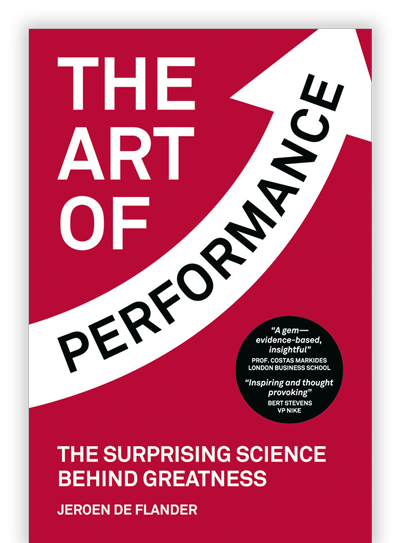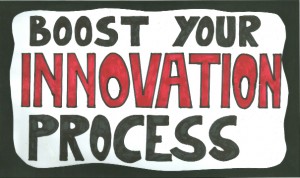A solid innovation process is crucial. Especially the steps in the innovation planning process are key. These steps are often called innovation process stages.
Companies constantly need to reinvent themselves to offer unique value to their clients. It not, their edge starts to erode. And they end up in a place they don’t want to be.
Just think about Nokia and you know what I mean.
But having a great innovation process is much more than being ‘creative’. Or having 7 stages of innovation.
Most companies find out the hard way.
We can’t just drop our brilliant ideas into the existing organization, sit back and wait until they deliver the value we want.
In this mini guide about disruptive innovation , you will discover the three steps (or stages) of a best-in-class innovation process. And learn how to manage the innovation process the right way.
Disruptive Innovation: the ultimate guide
- Innovation process definition
- Innovation process model
- Innovation process steps
- Innovation process management
- Quotes on Innovation
Innovation process definition?
Like ‘strategy’, ‘innovation’ is a cool word. Put ‘strategy’ and ‘innovation’ in a single phrase and a managers starts to drool.
People use the word ‘innovation’ in a variety of ways.
- For some, it’s all about technology and finding a technological edge.
- For others, it’s about creativity.
- A third group will try to convince you that it’s about attitude, culture and motivation.
- And the fourth group will tell you it’s about trying to predict future megatrends.
But the downside of all of these innovation definitions, the word becomes hollow. And doesn’t carry any meaning. It becomes very difficult for a leader to talk about innovation.
For me, the solution is to put the innovation process at the core of what your company does with regards to innovation.
If the three steps of the innovation process explained below are clear, it will be much easier for people to relate to the innovation goals you want to achieve.
We should innovate more and talk less about it!
A 3-step innovation process model
To succeed, every organization – large or small – needs structured innovation process steps, a model for managing innovation.
In fact, research from the performance factory shows that every successful innovation process has three distinct steps.
- The Search step
- The Incubation step
- The Execution step
Each step in the innovation process has different attributes for success. And therefore requires a specific approach.
Want to give your innovation process a boost? Look beyond the Search step (the creative part) and get ALL the building blocks of the innovation process in place.
Let’s take a closer look at each of the 3 innovation process stages:
Innovation process steps — (1) Search
This is what most people would call ‘innovation’ or ‘disruptive innovation’. It’s very often the only step they see. It’s the step where you look for new ideas to offer more value to your existing customers or come up with a value proposition for a new set of clients.
The Search phase requires a solid understanding of the industry and your target client segment. Very often, the closer you are to the action, the better insight you have.
Unfortunately, this first step is often centralized, which according to our experience is not smart. Searching for new ideas should be done in the field, by local resources that have the time.
Whether or not an idea makes it to the next phase – the Incubation phase – is determined by the rules of competition, the basics of strategy and competition.
In short, does your idea offer your company a sustainable competitive advantage that brings in enough earnings?
Bringing in enough money is especially important for larger organizations.
Why?
The larger your organization, the more future earnings an idea needs to potentially offer in order to be retained.
If your current business brings in one billion a year, you won’t want to waste your time on ideas with a future earnings potential of 25K euro. But if you are a 0.25 MIO turnover company, it could be great to pursue this.
As success is not guaranteed, you want to reward effort rather than results. You want to encourage revolutionaries, people who dare to think differently, those individuals that ask questions that others won’t.
Like Newton, the men who defined the laws of gravity started from a simple question: “Why should the apple always fall perpendicularly to the ground?”.
Innovation process steps — (2) Incubate
The second step in the innovation process is all about testing and growing ideas.
Just because an idea looks promising on paper doesn’t mean that it will deliver the value you expect. In my experience, the Incubation phase is crucial but often overlooked or poorly attended to by organisations that want to boost innovation.
Incubation demands a trial and error approach and mindset.
If you cannot handle failure and start over again, you will never succeed. Look at how venture capitalists operate: they launch themselves into several start-ups and only expect a return on a limited number of them.
The aim of the Incubation phase is to test value – to find out in the real world if customers are willing to pay for a certain value that you are offering.
It is crucial to test this with the right client. When you come up with a disruptive idea – one that targets a different client group with needs different to your current client segment – you need to manage the lack of enthusiasm from existing customers and not let that stop the execution.
Think about the research by Christensen (1997) when you define your target group: “Disruptive strategic innovations offer a different value proposition from what the established players offer. As a result, they attract customers that are different from the customers that the established players focus on. As a result, if you ask your own customers if they want them, they will lead you astray.”
Once the testing is finalized, you can detail a business case based on real data, and not only on wild guesses and random assumptions.
So whether an idea makes it to next phase – the Execution phase – depends on the test results and their translation into an honest business case.
Incubation is done by passionate people, by entrepreneurs who believe 200 percent in what they do. Larger organizations often lack entrepreneurial people, whereas they have more than enough strategists and managers.
It’s a self-selection process where (international) structures, size of operations and management opportunities attract people who thrive in this environment and suppress people who don’t.
We believe that one of the first things that a company wanting to boost innovation needs to do is look around for entrepreneurs who can pick up the ideas that come out of the Search step, test them with passion in the marketplace and hand them over to the managers that grow them further in the Execution step.
You should reward ‘intelligent’ failure; mistakes are allowed, but you want people to start from a specific set of tested assumptions (rather than just shooting from the hip), learn from mistakes and adapt.
You should also promote and encourage drivers, that small group of entrepreneurs in your organisation who are able to take an idea and passionately fight for it.
Innovation process steps — (3) Execute
This is the third and final step in the innovation process.
In this step, it’s all about growing the identified value of a specific idea.
Your tests show that the customer target group is willing to pay for the value offered and your honest business case indicates that the earnings from the idea will be large enough – in terms of earning potential compared to your company size and relative to other options you have.
Your goal is to reproduce the success of the test and turn it into a factory approach, a streamlined day-to-day activity that brings in the expected returns.
The key word is ‘streamlining’. You want to turn this into business as usual, a factory that grows the value.
The new activities can be integrated into the existing organisational structure, added alongside or set up separately.
Use a classical budget approach to manage activities, although it’s useful to go back to your honest business case every three to six months to see how well you predicted success and integrate the learnings into future business cases.
The role of ‘the manager’ as we know it is predominant. As a company, you want to reward results, encourage execution heroes and, importantly, punish low performers.
Innovation process management
“Many great ideas are trampled by the running business”
Besides setting up a best-in-class innovation process model, you also need to think about innovation process management.
The two most important innovation process management challenges are: (1) the potential conflict with the current business model and (2) the human side.
Let’s take a closer look at both of them:
The business model conflict
In order to manage the potential conflict with the current business model – you need to find out upfront where the potential conflict areas will be. The four most common conflict areas are:
1. Cannibalization of old business by the new idea: for example, a new e-shop keeps clients away from traditional stores.
2. A brand identity mismatch: for example, the brand attributes that you require to put the new idea into the marketplace are too hip and don’t fit with the current brand identity.
3. A culture and values mismatch: for example, the eye for detail and engineering you cherish for your main business is opposite to what you need for the B brand you launch.
4. Incentive system: for example, the remuneration policy for attracting and rewarding high-quality entrepreneurs does not fit with the existing reward approach.
Unfortunately, there is no magical solution to avoid these conflicts. It’s about choices and the trade-offs that you need to make.
Two important lessons from the best in-class-innovators are: set up an innovation process that forces you to make those choices very deliberately. And communicate them explicitly to the organization.
Here’s a communication example, “We launch a new e-shop but continue to invest in our physical retail channel. We know that our new e-shop will take away business from our traditional channel but we are convinced, based on the field test that we have done and research data we have collected, that it is an important step for us to take as the market is evolving fast. Let’s look at this in more detail…”
Remember: if people don’t understand a choice as a result of the innovation process, it will be very hard to keep them motivated.
Manage the human conflict in the innovation process
The two human elements you need to manage in the innovation process are:
1. “Ego”: the obvious threat
A new business presents a clear threat, especially when it becomes bigger. Managers from the existing business fear that they will lose power and influence and start to take action.
In most organizations, leaders don’t talk about these blocking hidden actions, but they do exist and harm new business.
2. “Size”: the invisible threat
Ideas that come out of the innovation process will have limited benefits at the start (think start-ups)
But they do need a lot of nurturing.
Some of the most important strategic decisions will need to be made during the Incubation period, a time when business volumes will be 0 or very small.
- When you are an entrepreneur and dedicate all your time to this new venture, you will give it all the attention and brain power to make the best possible choices – necessary because your future depends on it.
- When a senior executive deals with a new million dollar challenge every hour, what are the chances that he will give enough time and brain power to that small idea that needs to move through the incubation phase?
The answer will come as no surprise.
The result: good ideas don’t make it along the three steps of the innovation process because they are too small to get serious attention and brainpower from senior people. (and bad ideas keep going and going because nobody pays attention or pulls the plug.)
Innovation quotes
I hope you got a few pointers to model your innovation process. Before you move on, I would like to share with you my favorite innovations quotes.
Nothing works better changing a mindset than a great quote.
Use them to kick-start your next innovation discussion.
Want more? Here’s my complete list with quotes on innovation.
1. If you always do what you always did, you will always get what you always got. [Albert Einstein]

2. It’s tough when markets change and your people within the company don’t. [Harvard Business Review]

3. Necessity is the mother of invention. [Anonymous]

4. “Ideas won’t keep. Something must be done about them.” [Alfred North Whitehead]

5. Innovation is the ability to convert ideas into invoices. [L. Duncan]

6. “We have approximately 60,000 thoughts in a day. Unfortunately, 95% of them are thoughts we had the day before.” [Deepak Chopra]

7. Ideas are useless unless used. [T. Levitt]

and finally,
8. Innovation is anything, but business as usual. [Anonymous]

Want to read more:
- Check out the ultimate KPI guide!
Like this article about the innovation process steps?
Want to inspire others to innovate better?
Share now!




